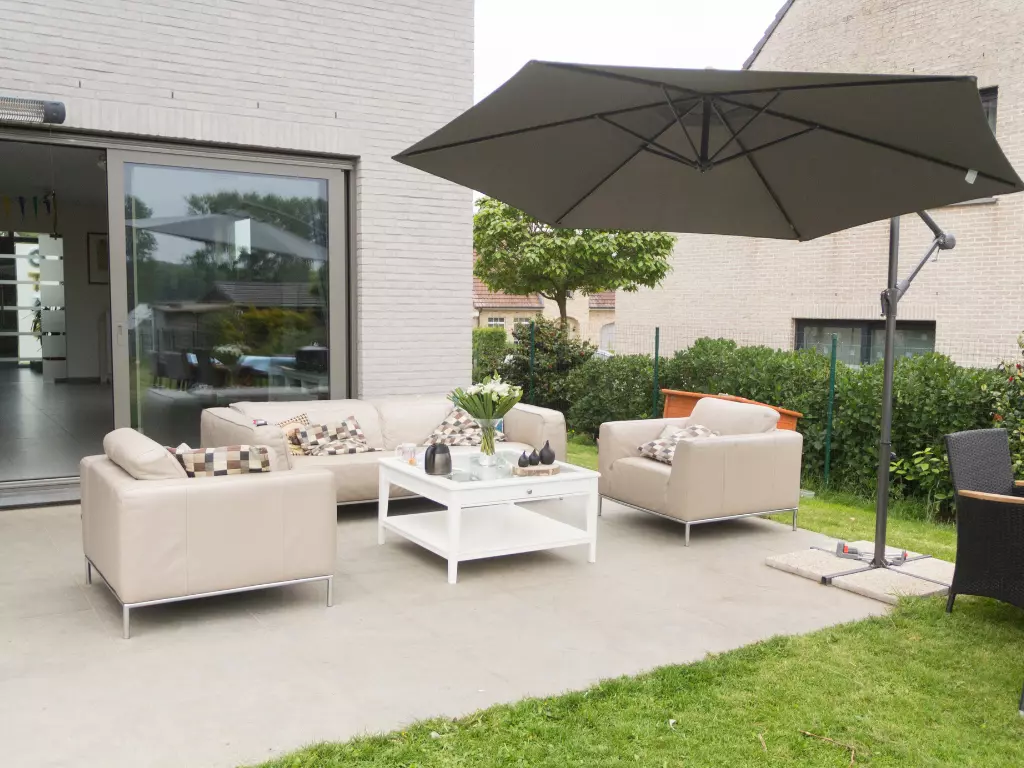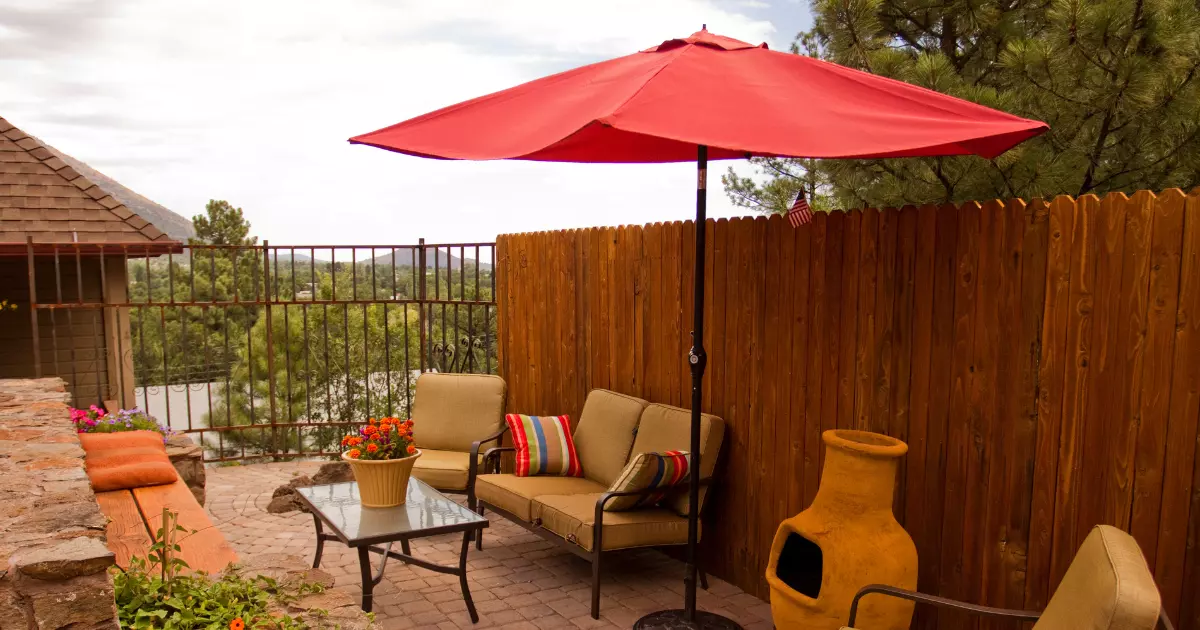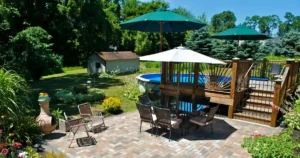One of the main questions folks have when setting up their outdoor space is “Can a Patio Umbrella Stand Without a Table?”. Umbrellas are a nice way to enjoy relaxing in the shade, but can they balance all by themselves? Or do you need a table underneath to hold it steady?
The short answer is – yes, an umbrella can stand alone! As long as it’s got a sturdy base to work with. While umbrellas are designed to function independently, a flat surface beneath, like a tabletop, barrel, or even a big planter, does provide some extra stability. Having something solid underneath helps stop a top-heavy umbrella from blowing over on windy afternoons.
There are a few things to think about to make sure a solo umbrella will stay okay. Factors like how heavy the base is, pole length, and canopy size all play a role. Location matters too – avoid really gusty spots if possible. But with the right umbrella and being careful with placement, you definitely don’t need a full patio table set up to enjoy the shade from your standalone friend. Just takes a little know-how to balance it beautifully on its own!
Benefits of a Freestanding Patio Umbrella

Placing an umbrella stand separately from patio furniture provides flexibility in shading different areas. Some key benefits include:
- Shade Where Needed – Position the umbrella to block the sun anywhere, not just where furniture is located. This allows for custom shade coverage.
- More Layout Options – Separating the umbrella stand gives you more freedom over furniture placement without having to arrange around a central table.
- Portability – A free-standing umbrella stand can easily be moved to shade different spots based on sun direction. Tables are bulkier and harder to reposition.
- Versatility – Stand-alone umbrellas work well-placed off-center of a seating area, used to shade pathways, gardens, play areas, or pools.
- Cost Effective – Getting a separate umbrella stand is cheaper than buying a full dining set. It’s an affordable way to add shade.
- Style Flexibility – Mix and match furniture styles more easily without needing a matching table. Go for any aesthetic.
Considerations for Stability
While patio umbrellas can stand solo, stability is a concern without a weighted base underneath. A strong breeze can easily tip over an umbrella without sufficient support. Consider these factors to keep your umbrella firmly in place:
- Umbrella Base Weight – The heavier the umbrella base, the more stability it will have freestanding. Look for stands weighing a minimum of 50 pounds. More weight is ideal for windy spots. Choose a portable base with built-in wheels if you want to move it around.
- Umbrella Height – The taller the umbrella pole, the more leverage and force the wind will have to push it over. Opt for a standard 7–8-foot pole height rather than 10 feet or higher to reduce the risk of tipping. Alternatively, use tie-down straps or stakes to secure it.
- Umbrella Canopy Size – A patio umbrella with a wider canopy catches more wind underneath, creating a billowing effect or sail. Limit canopy diameter to 9 feet or less for a stand-alone setup. Smaller is more stable.
- Location – Position the umbrella stand in a sheltered, less windy area of the patio, if possible. Avoid open yards without a wind block like a fence, plants or wall. Consider using multiple smaller umbrellas around seating areas rather than one large stand-alone.
- Stand Material – Heavy concrete, iron, resin, or stone stands provide the most anchoring power versus lightweight plastic bases. iron stands with a spike can be inserted into soil or grass for added stability.
- Ballast Weight – For lightweight stands, add ballast weight by inserting patio paver stones, bricks, or bags of sand inside any hollow cavities in the base. This lowers the center of gravity.
Best Practices for Freestanding Umbrella Setup
Follow these tips to maximize standalone umbrella stability:
- Place on a flat, level surface to distribute weight evenly. Avoid soft grass or dirt.
- Position away from high-traffic zones where people may bump into it.
- Check if your umbrella has a tilt function. Tilting it back slightly reduces wind resistance.
- Consider securing the pole to a fixed object like a fence post with ties to anchor it.
- Use a stand with multiple, wider-spread legs for better balance.
- Set legs on flat pavers underneath rather than directly on grass or dirt.
- Install an auto-tilt umbrella model that automatically rotates based on wind direction.
- Weigh down the stand if needed or lower the umbrella height in extreme wind conditions.
Ideal Stand-Alone Umbrella Locations

Certain patio spots lend themselves well to a free-standing umbrella setup. Optimal locations include:
- Near Seating Areas – Place a stand-alone umbrella just behind a sofa, chair, or lounger to provide customized shade coverage. Arrange seating around the umbrella’s periphery.
- Hot Tubs – Provide shade for hot tubs on open decks by locating an umbrella stand at the end of the tub. Ensure it’s positioned to avoid tipping over onto the tub.
- Off-center of Dining Sets – Stand a market-style umbrella off to the side of a dining table to shade part of the set. This leaves some direct sun for uncovered diners.
- Over Hangout Zones – Create an inviting hangout area anywhere by putting an umbrella stand over a rug, cushions, or outdoor poufs. Consider including a compact cocktail table to hold refreshments.
- Near Play Areas – Locate umbrellas near kids’ play areas in yards or buggy parking at pools. Just ensure kids don’t hang on the canopy or pole.
- Along Pathways – Line walkways with standalone umbrellas between gardens, porches, or seating zones. Leave enough clearance so people don’t bump poles.
Patio Table Alternatives for Stability
While freestanding umbrellas work in calm conditions, adding an underlying surface for stability is smart in windy yards. Some subtle alternatives to bulky patio tables include:
- Propane Fire Pits – Many propane fire pits like flat-topped models can support an umbrella pole inserted into a sleeve hole. Choose a large 30″+ pit to allow umbrella clearance.
- Side Tables – Small square side tables, ottomans, or garden stools with flat tops can be used. Ensure the umbrella pole doesn’t go past table edges.
- Planters – An oversized planter, urn, or ceramic pot can support an umbrella pole inserted through a drainage hole. Use very large, heavy containers.
- Paver Stones – Arrange flat paver stones or bricks into a square formation and insert an umbrella pole in the center hole. Add pavers around the base perimeter to prevent tipping.
- Deck or Patio Boxes – Build a custom wooden box frame to the size of an umbrella stand and attach it to the deck or patio. Fill it with sand or stones to weigh it down.
- Pools or Spas – Position the umbrella stand at the pool or hot tub edge so the pole extends directly over the water. The stand sits on the deck while the umbrella top provides shade.
Securing Your Umbrella from Wind
High winds can easily knock over an exposed umbrella and turn it into a projectile. Ensuring stability is key, especially if placing it freestanding without a weighted table base. Several proven techniques exist:
- Weighted sandbags – Sandbags work well as inexpensive ballast. Look for thick canvas bags that seal tightly when full of damp sand. Place a few bags around the base perimeter, making sure to spread their weight evenly. For peace of mind, you could even attach the bags to the pole itself using strong nylon straps. Just be cautious not to overfill causing ripped seams! During storms, keep the bags secured rather than leaving them exposed where gusts could pick them up.
- Ground spikes/stakes – Thick steel stakes easily hammer into soil or grass and feature eyelets near the pointed tip. Attach durable rope or aircraft cable from the stakes up to the grommets on the pole itself, forming an angled support system. Pull the lines taut but not so tight the umbrella cannot still pivot normally. Over time, check that the stakes remain driven well into the ground as the soil settles. Come spring, they may need a few whacks to be reset at the same depth.
- Guy wires – Strong wire or rope connects umbrella poles to fixed anchors like stakes, fencing, and buildings. Adjust tension as winds change. Install pulleys for easy adjustment.
Patio Umbrella Mechanisms that Sway with the Breeze
Rather than fighting strong breezes, the smartest umbrellas integrate tilting bases or pivot joints designed to yield gracefully to gusts. Some high-end automatic models even sense incoming wind direction changes and nimbly adjust the canopy angle accordingly without human assistance!
- Tilt mechanisms – The tilt mechanism, usually located where the pole meets the base, allows the entire umbrella to lean or lower in a controlled manner. This reduces the overall wind profile or “sail effect” trying to catch the canopy. Manually operated tilt models respond when you push a lever, while automatic options detect forces and react independently. Either way, the moving parts need occasional lubrication using a lightweight machine oil to ensure smooth, unbinding movement during windy episodes.
- Auto tilt models – Sensors detect changes in wind direction and tilt the canopy accordingly to maintain optimal wind resistance. More expensive but lowest maintenance.
Material Choices for Patio Umbrella

- Metal: Durable powder-coated aluminum is rust/impact resistant but heavy. Galvanized steel is less costly.
- Weather-resistant fabrics: Solution-dyed acrylics or polyester stands up to UV and mildew. Look for reinforced seams. Glass is strongest but fragile.
- Plastics: Inexpensive but more prone to bending, cracking, or breaking over time, especially in elements. Avoid unstable setups.
Maintenance Tips for Patio Umbrella
Taking basic care extends any umbrella’s useful lifespan. As with all things kept outdoors, cleaning removes built-up grime improving appearance plus reduces fabric drying which can lead to brittleness over time.
- Clean canopy/poles periodically with mild soap. A mild soap and water solution in a pump spray bottle does the trick. Wipe down entire structures including poles, pulls, and joints at the start and end of each season.
- Tighten any loose screws or bolts that may have vibrated loose over winter storms too. Simple tasks now prevent major repairs or full replacements down the road.
- Inspect guidelines/cords for wear and replace as needed.
- Lubricate moving parts like joints with light oil.
- Replace worn/damaged canopy, pole sections, or hardware as needed.
- Store properly during the off-season to prevent weather damage.
Some furniture securing methods also work for freestanding umbrellas.
Liability Warnings for Patio Umbrella
- Improperly secured umbrellas can become dangerous projectiles in high winds.
- Inspect setup regularly and secure or store away before storms arrive.
- Manufacturer and seller are not responsible for misuse or improper installation.
Permit Needs for Patio Umbrella
- Permanently installed attachments or large commercial models may require building permits.
- Check with the local code office for requirements in your area regarding heights, and placements.
Seasonal Storage
- Fully close the canopy and tie it down securely for winter.
- Disassemble pole sections and store them indoors in a dry location.
- Cover stationary bases with outdoor tarps to prevent water damage.
Key Takeaways on Freestanding Umbrellas

Here are some final tips on successfully using patio umbrellas without tables or bases underneath:
- Stability is a potential issue to consider, especially in windy conditions. Properly weighing down and securing the stand is key.
- Focus on finding a very heavy umbrella base stand, ideally 50+ pounds or more. Extra ballast weight can be added.
- Umbrella height under 8 feet, canopy size under 9-foot diameter, and sheltered locations are ideal for stand-alone setups.
- Make sure the umbrella stand sits on a 100% flat, level surface and position away from high-traffic zones.
- Smaller, multiple umbrellas provide more flexible shading options around patio furniture groupings.
- If your outdoor space is very windy, consider anchoring to a fixed structure or using a patio table base for stability.
With the right umbrella stand, location, and setup, achieving stylish shade is possible in your yard without requiring a patio table underneath. Follow these tips for successfully installing a stable, freestanding patio umbrella. For more tips on factors to consider before purchasing a patio umbrella, check out The Spruce guide on how to pick out the right umbrella for your needs.
Frequently Asked Questions (FAQs)
Q: How heavy does the umbrella base need to be?
Aim for at least 50 lbs., with heavier being better for windy areas. You can also add extra weight like stones.
Q: What size umbrella can stand alone?
Stick to smaller canopy sizes (9 ft or less) and heights under 8 ft for stability without a table.
Q: Are sandbags or stakes better for securing it?
Both work well – sandbags provide ballast while stakes anchor into the ground. Use both for maximum stability.
Q: What surfaces are best for the stand?
100% flat and level surfaces like concrete or pavers. Avoid soft grass, dirt, or uneven spots.
Q: How often do I need to tighten stakes/wires?
A: Check them at least once a year before the season starts as soil and weather can cause connections to loosen.
Q: Is it safe to leave up overnight or in storms?
No, high winds can cause improperly secured umbrellas to become dangerous projectiles. Always store away before severe weather.
Q: Do auto-tilting models really work automatically?
Yes, higher-end models have sensors that detect wind changes and adjust the canopy angle accordingly without manual adjustment.
Q: How long do materials typically last?
A: Quality construction should withstand weather for 5-10 years with proper care and seasonal storage when not in use.
Q: Are permits required for permanent installations?
Check local building codes, as large or anchored commercial models may require a permit.







